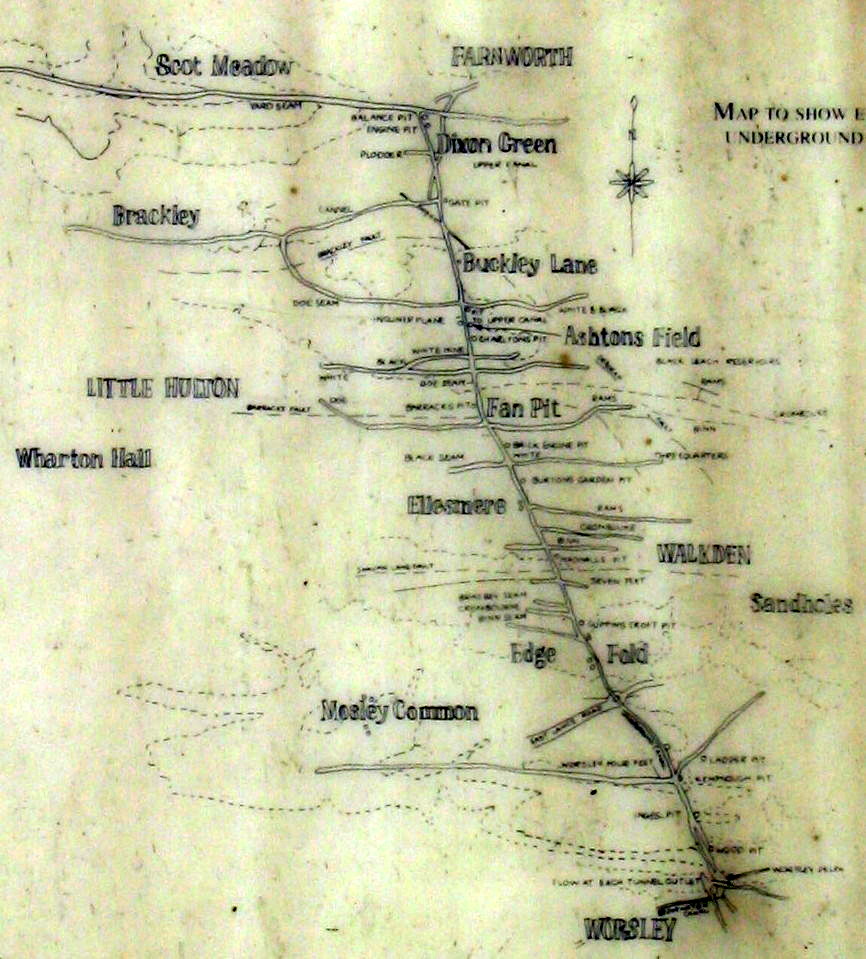Bridgewater Collieries was a coal mining company on the Lancashire CoalfieldThe Lancashire and Cheshire Coalfield in North West England was one of the most important British coalfields. Its coal seams were formed from the vegetation of tropical swampy forests in the Carboniferous period more than 300 million years ago. with headquarters in Walkden near Manchester. The company originated from the coal mines in the underground levels in WorsleyExtensive network of underground canals that drained the Duke of Bridgewater's coal pits emerge into the open at the Delph in Worsley, Greater Manchester. and the surrounding area of Lancashire owned by Francis Egerton, 3rd Duke of Bridgewater in the second half of the 18th century. Under the terms of the duke’s will, his estate was managed by the Bridgewater Trustees until the Earl of Ellesmere inherited the estates in 1903. The company was formed in 1921, and merged with other prominent mining companies to form Manchester CollieriesCoal mining company with headquarters in Walkden, Lancashire, formed in 1929 by the merger of a group of independent companies operating on the Manchester Coalfield. Coal mining company with headquarters in Walkden, Lancashire, formed in 1929 by the merger of a group of independent companies operating on the Manchester Coalfield. in 1929.
Background
Small-scale coal mining was carried out where coal seams outcropped in Worsley and the surrounding areas from the Middle Ages. John Egerton, the 1st Duke of Bridgewater, inherited the Worsley estate in 1730.[1] He died in 1745, and his heir John died in 1748, when the estate passed to Francis Egerton the 3rd duke, who took control in 1757 when he reached the age of 21. He was keen to exploit the mineral resources under the largely agricultural estate, but the coal pits he inherited were small and particularly wet, as water percolated through porous sandstone above the coal seams. The duke hired James Gilbert as his agent and, while planning the Bridgewater Canal to transport coal to Manchester, Gilbert had the idea of extending the canal underground to drain the coal workings and provide a means of transporting coal to the Delph, an old sandstone quarry in Worsley, which became the start of the Bridgewater Canal. Gilbert’s idea was developed into an extensive system of underground canals, the Worsley Navigable LevelsExtensive network of underground canals that drained the Duke of Bridgewater's coal pits emerge into the open at the Delph in Worsley, Greater Manchester..[2]
Bridgewater Trustees
After the duke’s death in 1803, under the terms of his will, his estate was managed by trustees until the Earl of Ellesmere inherited the estates in 1903. Robert Haldane Bradshaw, the trustees’ superintendent, acquired the mineral rights from surrounding estates. He bought the Chaddock estate in TyldesleyFormer industrial town in the Metropolitan Borough of Wigan, in Greater Manchester. and the Booths estate in Boothstown in 1810,[3] and the Garrett HallFormer manor house and now a Grade II listed farmhouse in Tyldesley, Greater Manchester, England. estate in Tyldesley in 1829. By 1830 more than 300 shallow pits had been sunk, including some at Wardley, near the Preston to Manchester road[a]now the A6. In the 1830s the Burgess Land Pit was sunk to north of Ellenbrook,[4] and the City and Gatley pits at New ManchesterFormerly isolated mining community at the extreme eastern end of the Tyldesley township. were sunk in the 1840s.[5]
Information provided to the Mines Inspectorate in 1853 showed that the trustees had 25 working pits and 37 old pits that were “fenced off”, a workforce of 1100 men and boys and that almost 275,000 tons of coal had been raised in the previous year. The trustees had 12 high-pressure steam engines for winding or pumping, seven beam engines, two atmospheric engines and a horse gin. They also had built coke ovens at Dixon Green, Walkden and Worsley.[6]
The Bridgewater Trustees began sinking deep shafts close to Ellenbrook in 1862, which became known as Mosley Common Colliery.[7] During the 1860s deep pits were sunk at Ashtons Field, Ellesmere CollieryEllesmere Colliery in Walkden, on the Lancashire Coalfield, was sunk in 1865 by the Bridgewater Trustees. Production ended in 1923. and Linnyshaw.[8] In 1878 the trustees developed Brackley Colliery in Middle Hulton and developed Charltons and Wharton Hall CollieryWharton Hall Colliery was in Little Hulton on the Lancashire Coalfield in Lancashire, north west England., which they bought in 1862.[9]
The trustees built the Bridgewater Offices in the centre of Walkden in 1868. The superintendent, manager and agent were based in the prestigious building along with sales staff and surveyors. The offices became the headquarters of Manchester CollieriesCoal mining company with headquarters in Walkden, Lancashire, formed in 1929 by the merger of a group of independent companies operating on the Manchester Coalfield. Coal mining company with headquarters in Walkden, Lancashire, formed in 1929 by the merger of a group of independent companies operating on the Manchester Coalfield. after 1929 until nationalisation in 1947.[10]
End of the trust
The trust was wound up in 1903 and the Earl of Ellesmere took over as sole owner. In 1911 it was reported that the company had a bright future with large unworked coal reserves. The underground levels still drained the workings and the collieries had been modernised. The most important collieries were Mosley Common, Brackley, Wharton Hall, Bridgewater (Sandhole), Ellesmere, Linnyshaw and Ashtons Field.
In 1923 the Ellesmere family left Worsley and the estates and collieries were owned by Bridgewater Collieries, a subsidiary of Bridgewater Estates.[11] In 1923 Ellesmere ceased production and Ashtons Field and Linnyshaw closed before the decade ended. In 1929 the company was one of several that merged to form Manchester Collieries.[11] By 1947, when Britain’s collieries were nationalised, just three ex-Bridgewater pits were still operating: Brackley, Bridgewater and Mosley Common. As the market for coal was challenged by oil, Bridgewater closed in 1962, Brackley in 1964 and Mosley Common in 1968.[12]


